Fellner & Helmer
Fellner & Helmer was an architecture studio founded in 1873 by Austrian architects Ferdinand Fellner and Hermann Helmer.
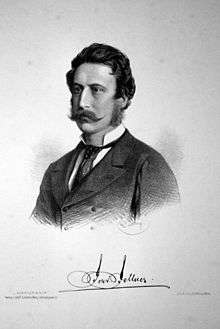
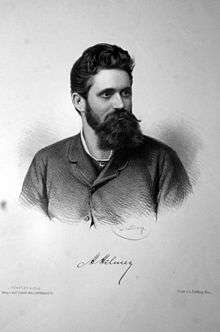
Ferdinand Fellner and Hermann Helmer
They designed over 200 buildings (mainly opera houses and apartment buildings) across Europe in the late 19th century and early 20th century, which helped bind the Austro-Hungarian Empire together and cement Vienna as its cultural center.[1][2] While most of the work stood in the former Austro-Hungarian Empire, others can be found from Switzerland to present-day Ukraine. Frequent collaborators for integrated exterior and interior art work include Gustav Klimt, Hans Makart, Theodor Friedl, and other significant artists.
Theatres by Ferdinand Fellner
Timișoara National Theatre, Austro-Hungary, now Romania. Only the side wings were restored according to the original design.
- 1871–72 Stadttheater, Vienna, Austria, (destroyed by fire in 1884). With Ferdinand Fellner the Older.
- 1871–75 Timișoara National Theatre, Romania. With Ferdinand Fellner the Older.
Theatres by Fellner and Helmer
Original design of the Rijeka theatre's west façade (1882)
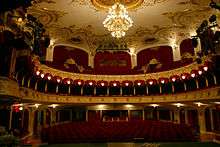
Katona József Theater auditorium

National Theatre of Szeged, (1883)
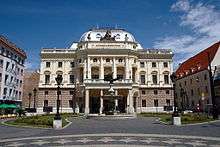
Slovak National Theatre, Bratislava, (1885-86)

Odessa Opera Theater (1887)
Volkstheater, Vienna, (1889)
Oradea National Theatre, (1900), Austro-Hungary, now Romania
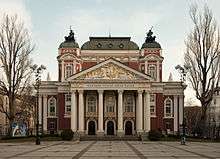
Ivan Vazov National Theatre in Sofia, Bulgaria (1906)
Theatres designed by Fellner & Helmer[1]
- 1874–75 Népszínház, Budapest, Hungary (demolished 1965)
- 1881–82 Mahen Theatre in Brno, Czech Republic, (the first theatre in Europe with electrical lighting)
- 1881–83 "Stadttheater" in Liberec, Czech Republic
- 1882–83 Szeged National Theatre, Hungary
- 1883–85 Croatian National Theatre in Rijeka, Croatia
- 1884–86 Theatre in Karlovy Vary, Czech Republic
- 1884–87 Opera Theater, Odessa, Ukraine
- 1885–86 Slovak National Theatre (as "Königliches Freistädtisches Theater"), Bratislava, Slovakia, 1886
- 1886–87 Prague State Opera (as "Neues Deutsches Theater"), Prague, Czech Republic
- 1887–88 Ronacher, Vienna, Austria (altered after fire)
- 1888–89 Volkstheater (previously Deutsches Volkstheater), Vienna, Austria
- 1890–91 Opera House, Zürich, Switzerland
- 1891–92 Komische Oper in Berlin, Germany
- 1892–93 State Theatre in Salzburg, Austria
- 1892–94 Hessisches Staatstheater Wiesbaden, Germany
- 1893–95 Tonhalle, Zürich, Switzerland
- 1894–95 Croatian National Theatre in Zagreb, Croatia
- 1894–96 Iaşi National Theatre, Romania
- 1895–96 Vígszínház in Budapest, Hungary
- 1895–96 Katona József Theatre, Kecskemet, Hungary
- 1896–97 Konzerthaus Ravensburg, Germany
- 1898–99 Opernhaus in Graz, Austria
- 1898–99 Stadttheater in Berndorf, Austria
- 1899–00 Oradea National Theatre, Oradea, Romania
- 1899–00 Deutsches Schauspielhaus, Hamburg, Germany
- 1901–02 Stadttheater Fürth, Germany
- 1902 Theater an der Wien, Vienna, Austria (altered 1960-61)
- 1903–04 Wilam Horzyca Theatre in Toruń, Poland
- 1904–05 Theatre in Chernivtsi, Ukraine
- 1904–06 Ivan Vazov National Theatre, Sofia, Bulgaria
- 1904–06 Cluj-Napoca National Theatre, Cluj-Napoca, Romania
- 1906–07 Theatre in Jablonec nad Nisou, Czech Republic
- 1906–07 Stadttheater Gießen, Germany
- 1906–09 Theatre in Mladá Boleslav, Czech Republic
- 1908–09 Stadttheater, Baden bei Wien, Austria
- 1909–10 Stadttheater in Klagenfurt, Austria (expansion 1996-98 by Günther Domenig)
- 1909–1910 Stadttheater Teschen, Ö.-Schlesien / Cieszyn, Poland
- 1910–13 Konzerthaus, Vienna, Austria
- 1911–13 Akademietheater, Vienna, Austria
Other buildings
- 1881 the István Károlyi or Károlyi-Csekonics Palace, Múzeum utca 17 in Budapest's Palace District, Hungary
- 1885 Palace Modello in Rijeka, Croatia
- 1894 Palais Rothschild, Prinz-Eugen-Straße, Vienna, Austria
- 1894–95 Palais Lanckoronski, Vienna, Austria
- 1897 Castle, Žinkovy, Czech Republic
- 1897–1898 Noble casino, Lviv, Ukraine
- Colonnade Park (Czech: Sadová kolonáda), Karlovy Vary, Czech Republic
- Grandhotel Pupp, Karlovy Vary, Czech Republic
- Hotel Slovan (as "Hotel Waldeck", 1893) in Plzeň, Czech Republic
- Imperial bath (Bath I), Karlovy Vary, Czech Republic
- Market Colonnade, Karlovy Vary, Czech Republic
- Art Pavilion in Zagreb, Croatia, 1898[3]
- Palace of Justice, Suceava, Romania, 1885
- 1898–1900 Goetz Palace in Brzesko, Poland
- 1899–1900 Hotel George, Lviv, Ukraine
- Potocki Palace, Antoniny, Ukraine
- Villa, 20 Mickiewicza Street in Toruń, Poland
- Semmering: Hotel Panhans
- Semmering (Niederösterreich) - Dependance Waldesruhe 1908
- Semmering (Niederösterreich) - Dependance Fürstenhof
- Department store Kastner & Öhler in Graz (1914)
Sources
- "Theatres built by Fellner & Helmer". andreas-praefcke.de. Retrieved 2006-07-30.
Notes
- Architekturzentrum Wien: "Ferdinand Fellner II.", (in German), retrieved 30 March 2013
- How One Vienna Architecture Firm Defined the Opera House in Central Europe
- Damjanovic, Dragan. "Croatian Pavilions at the 1896 Millennium Exhibition in Budapest, in: Ephemeral Architecture in Central and Eastern Europe in the 19th and 21st Centuries, L'Harmattan, Paris, 2015, 51-74". Cite journal requires
|journal=(help)
gollark: I'd actually quite like that if it wasn't also horribly violating privacy.
gollark: Well, they can probably *hear* you, then.
gollark: And that it'll still know stuff like when you arrive or leave... actually, do they have microphones?
gollark: And explicitly say Ring is Amazon?
gollark: Did you compare them, or something?
External links
![]()
This article is issued from Wikipedia. The text is licensed under Creative Commons - Attribution - Sharealike. Additional terms may apply for the media files.